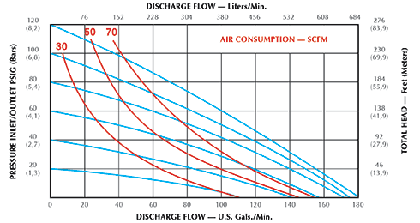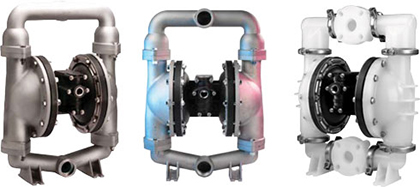No matter what new developments occur in the world of diaphragm pumps, there are certain questions that never change. Here, we’ll resolve ten of the most frequently asked questions about air operated diaphragm pumps.
1. HOW DO I KNOW WHAT TYPE OF AIR OPERATED DIAPHRAGM PUMP TO BUY?
While this seems like a loaded question, there are only five things you need to know when selecting the right pump for your particular application.
Fluid: The type and composition of the fluid you plan to pump is the most important factor when choosing a pump. In order to avoid wear and tear or corrosion, determine the fluid’s chemical makeup and consistency. Is it a clean fluid or slurry (semiliquid mixture)?
Viscosity: Fluid viscosity is an important factor in to the pump selection process. Robust pumping equipment is needed to move highly viscous fluids. To provide some perspective, at All-Flo, nine out of ten customers are pumping fluid less viscous than motor oil.
Flow rate: In order to select the appropriate pump, it’s important to determine the flow rate, measured in gallons per minute (GPM)—or in simpler terms, the existing pump size (diameter). Usually if you desire a higher flow rate, you’ll need both a larger pump and larger pipe size.
Pressure: Determining the potential pressure conditions on the inlet and outlet of the pump will help establish the right equipment needed.
Temperature: The temperature of the fluid dictates the pump material best suited to a particular application.
2. WHAT KIND OF FLUID DOES A DIAPHRAGM PUMP TRANSFER?
Diaphragm pumps will move nearly any kind of fluid. Some common examples of fluids pumped using a diaphragm pump are water, oil and acid.
Diaphragm pumps are capable of pumping high viscosity fluids from adhesives and gear oils to hand lotions, surfactants and resins. The rule of thumb: If it pours, it pumps. Use large suction lines when pumping viscous fluids, in some cases up to three times the size of the pump ports. The pump should also be positioned close to, or even below, the fluid level. Higher viscosity fluids cause the pump to stroke more slowly; adjusting the air control valve on the pump to slow the air flow will keep the pump from stroking too fast.
3. ARE THERE SPECIFIC CONSIDERATIONS FOR PLASTIC DIAPHRAGM PUMPS?
Plastic diaphragm pumps are best suited for applications involving chemicals like acids, caustics, and bleach. Some chemicals are not suitable for plastic pumps such as styrene and certain resins like isocyanate and polyol.
A common follow up to this question is, “Do plastic pumps always leak?” The answer is no; however, they should be regularly inspected and retightened more frequently than a metal or stainless pump. Frequency of tightening depends on the application; pressure, hours in service and fluid temperature will all affect the flow of plastic. Remember, plastic materials flow when compressed. Tightening the fasteners on your plastic diaphragm pump should be a part of any preventative maintenance program, based on the pump’s service duty.
4. WHAT ARE THE KEY FACTORS FOR DIAPHRAGM PUMP MAINTENANCE?
In order to avoid expensive repairs and delays, and keep your production running smoothly, you should implement a regular pump maintenance schedule. The good news: air operated diaphragm pumps are very easy to clean and maintain, compared to other types of pumps with a lot of electrical components and parts. Even better, in most cases, you’ll only need a wrench and a screwdriver to keep your pump in top working condition.
There are four main tasks to keep in mind when performing regular pump maintenance:
Air quality: Since air operated diaphragm pumps depend on air to operate, air quality and air moisture are critical to maintaining your pump’s health. Regularly check the air filter, which can become dirty and clogged with poor air quality. Moisture in the air should also be monitored to ensure proper pump flow.
Elastic components: Examine the pump’s elastic components every two months to safeguard against uneven wear.
Inlets/Outlets: Consistently inspect your pump’s inlet/outlet, also known as suction side/discharge side. It is common for rocks or other debris material to build up and clog pump flow.
Torque settings: Particularly with plastic diaphragm pumps, you should regularly check the torque of the pump’s bolts. Plastic components can compress over time.
5. WHAT KINDS OF FACILITIES USE DIAPHRAGM PUMPS?
Facilities of all sizes, and in a broad spectrum of industries, use air operated diaphragm pumps. These include petrochemical, metal fabrication, mining, water, construction, cleaning, food and beverage, and printing and ink.

6. HOW DO YOU REGULATE THE FLOW OF A DIAPHRAGM PUMP?
There are three ways to regulate the flow of a diaphragm pump.
- Increase or reduce air pressure, ensuring you are within the pump’s operating limits.
- Increase or decrease the amount of air volume using a valve on the air line.
- Open or close a valve on the fluid discharge.
There is only one firm warning when regulating flow: Never restrict your pump’s fluid suction lines. Restricting fluid lines causes your diaphragm to fail and begin running in a state of cavitation, causing parts to wear rapidly and creating vacuum-void bubbles in the fluid being pumped.
7. CAN I REPLACE ONE BRAND OF DIAPHRAGM PUMP WITH ANOTHER?
Sometimes. The key factor when considering a different brand of diaphragm pump is your existing footprint. Several major manufacturers, including All-Flo, produce nearly every diaphragm pump specifically to drop-in ready specifications. This means that most of our pumps can be used in any existing footprint. If you are looking to make a switch, carefully consider your existing set up and ask your distributor to help identify a suitable alternative.
8. WHAT SUCTION LIFT CAN I EXPECT FROM A DIAPHRAGM PUMP?
Features like suction lift tend to vary widely from manufacturer to manufacturer, and depend on factors like the size of the pump, fluid viscosity, and whether you’re looking for wet or dry lift. A safe, average range would be between 8 to 15 feet (2.44 to 4.57 meters) depending on the pump’s elastomers.
9. CAN A DIAPHRAGM PUMP BE SUBMERGED?
Yes, a diaphragm pump can be submerged if the fluid is compatible with the pump housing and fasteners, and if the exhaust is piped above the fluid level.

10. HOW MUCH DOES IT COST TO RUN A DIAPHRAGM PUMP?
As with all things related to diaphragm pumps, the cost to run it depends on several factors including pump size and hours in service. Another key factor is the brand of pump you choose and that product’s efficiency rating. To give you an idea, 2-inch (51-millimeter) diaphragm pumps range in price from $1400 to $6000 and can cost anywhere from $3000 to $11,000 per year to operate.
The cost to run a diaphragm pump can often significantly surpass the cost of the pump itself. Because of this, a great deal of time and research is spent on maximizing pump efficiency, and significant strides are being made to reduce the cost of operation.
Across a range of industries, pump users demand equipment that works as reliably as it does efficiently. And when your equipment performs with the versatility and durability that your application demands, you can keep things running smoothly. Air operated diaphragm pumps are rugged, lube-free, non-stall/freeze pumps that provide the high quality, trouble-free, continuous output—even under the toughest conditions.
_______________________________________________________________________
ABOUT THE AUTHOR
Steve Weirich is the application engineer at All-Flo Pump Co. A thirty-year veteran of the pump and process equipment industry, Steve regularly runs educational webinars and pump training courses. For more information about All-Flo, visit www.all-flo.com.
_______________________________________________________________________
MODERN PUMPING TODAY, June 2013
Did you enjoy this article?
Subscribe to the FREE Digital Edition of Modern Pumping Today Magazine!



